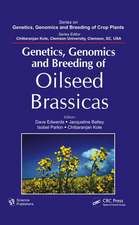Advances in Microbial Control of Insect Pests
Editat de Rajeev K. Upadhyayen Limba Engleză Hardback – 30 ian 2003
| Toate formatele și edițiile | Preț | Express |
|---|---|---|
| Paperback (1) | 1223.11 lei 6-8 săpt. | |
| Springer Us – 30 noi 2010 | 1223.11 lei 6-8 săpt. | |
| Hardback (1) | 1231.32 lei 6-8 săpt. | |
| Springer Us – 30 ian 2003 | 1231.32 lei 6-8 săpt. |
Preț: 1231.32 lei
Preț vechi: 1501.62 lei
-18% Nou
Puncte Express: 1847
Preț estimativ în valută:
235.61€ • 246.66$ • 194.95£
235.61€ • 246.66$ • 194.95£
Carte tipărită la comandă
Livrare economică 05-19 aprilie
Preluare comenzi: 021 569.72.76
Specificații
ISBN-13: 9780306474910
ISBN-10: 0306474913
Pagini: 330
Ilustrații: XI, 330 p. 25 illus.
Greutate: 0.84 kg
Ediția:2003
Editura: Springer Us
Colecția Springer
Locul publicării:New York, NY, United States
ISBN-10: 0306474913
Pagini: 330
Ilustrații: XI, 330 p. 25 illus.
Greutate: 0.84 kg
Ediția:2003
Editura: Springer Us
Colecția Springer
Locul publicării:New York, NY, United States
Public țintă
ResearchDescriere
The insect!1 remain in symbiotic associations with a tremendous number of microorganisms, and some of them could be classified as parasitic/pathogenic. Without question, insect pathogens act as natural mortality agents and represent the third leg of the triad of biological control which is an environmentally sound alternative to chemical control. The virulence and pathogenicity of an insect parasite i. e. disease agent are determined by the microbial genome as a result of the coordinated expression of a concert of genes. These genes may be organized as cassettes and be associated with transmissible DNA. The acquisition of these domains or pathogenicity islands, may be sufficient to develop a transgenic virulent pathogen. The insect pathogens are very specific and this property can be exploited in making insects sick. However, rarely have field applications of highly virulent strains of viruses, fungi, bacteria, protozoa resulted in massive insect population reductions or induced widespread, persistent epizootics as the same is also governed by host susceptibility regulated by genetics, age, sex and physiological state of the host. Insect pathogens causing acute or chronic diseases must be able to persist in the environment, to multiply in the host, and to spread to other susceptible hosts. In this book, I have attempted to bring together all recent studies regarding both fundamental and more applied research aspects related to entomopathogens, bacteria, viruses, fungi and nematodes in order to facilitate their development and commercial exploitation.
Cuprins
Aminopeptidase N as a Receptor for Bacillus thuringiensi Cry Toxins; R. Sato. Molecular Biology of Bacillus thuringiensis; Ming Sun, Lei Zhang, Yu Ziniu. Bacillus sphaericus: Mechanism and Application as a Mosquito-Larvicide; Yuan Zhiming. Insect Pest Resistant Transgenic Crops; P. Ananda Kumar. Molecular Biology of Insect Viruses; Zhihong Hu, Xinwen Chen, Xiulian Sun. Genetic Enhancement of Baculovirus Insecticides; B.C. Boning, A.J.Boughton, Hailing Jin, R.L. Harrison. Baculovirus Genomics: A Resource for Biocontrol; V.K.Ward, K.M.B. Sneddon, O. Hyink, J. Kalmakoff. Entomopathogenic Fungi as Potential Biocontrol Agents for Tsetse Flies; N.K. Maniania, C. Laveissiere, A. Odulaja, S. Ekesi, H.R. Herren. Metarhizium anisopliae: An Effective Biological Control Agent for the Management of Thrips in Horti- and Floriculture in Africa; S. Ekesi, N.K. Maniania. Fungi for Biological Control of Brassica Root Flies, Delia radicum, and Delia floralis; J. Eilenberg, R. Meadow. Use of Entomopathogenic Fungi in Latin America; S.B. Alves, R.M. Pereira, R.B. Lopes, M.A. Tamai. Microbial Control of Insect Pests with Entomopathogenic Fungi in China: A Decade's Progress in Research and Utilization; Ming-Guang Feng. Use of Entomopathogenic Nematode (EPANs) in Biological Control; Z. Mracek. Entomopathogenic Nematodes for the Control of Crop Pests; S.S. Hussaini. Genetic Improvement of Entomopathogenic Nematodes for Insect Biocontrol; C.W. Brey, S. Hashmi. Mathematical Models of Insect Pest Control; R.A. Norman, A.C. Fenton, J.P. Fairbairn, P.J. Hudson. Index.




